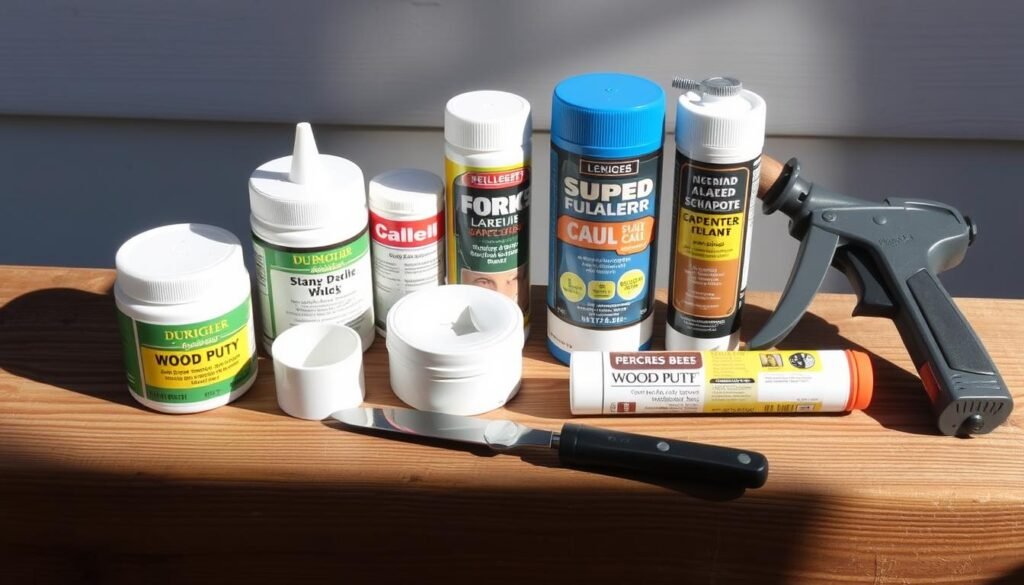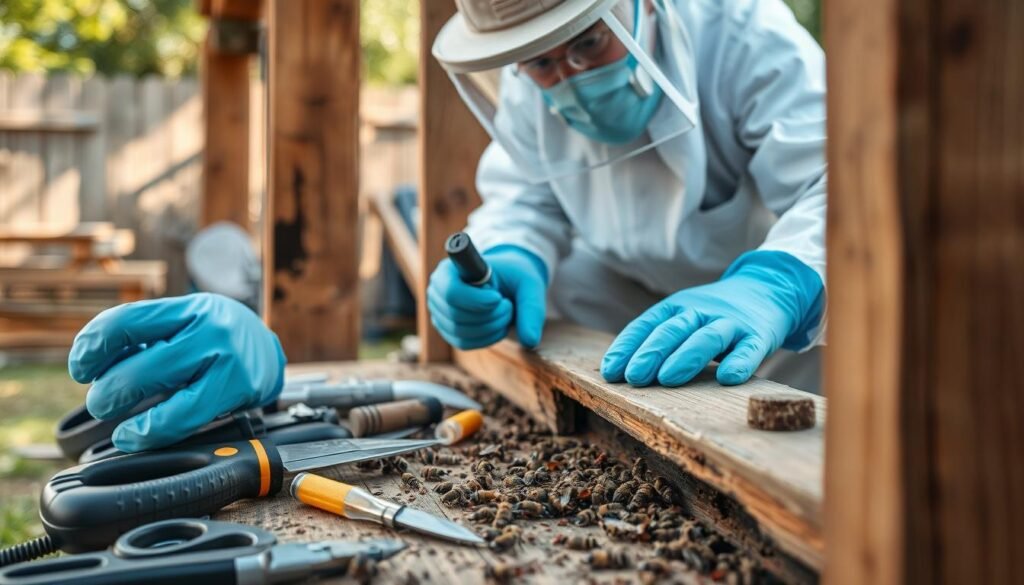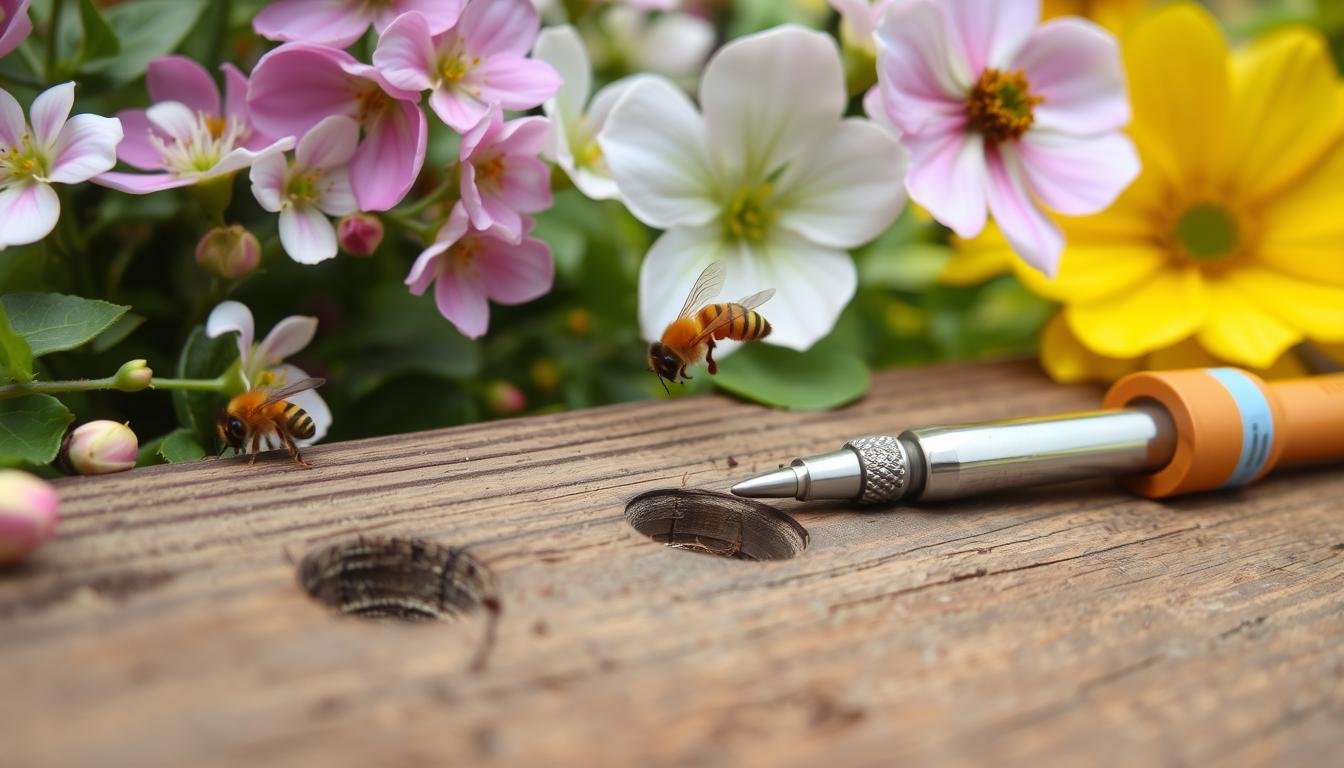Did you know a single female carpenter bee can lay 6 to 10 eggs? This fact shows how fast damage can grow in our homes if we ignore them. Carpenter bees like to nest in unfinished or untreated wood. Knowing should I plug up carpenter bee holes is key to controlling them and fixing the damage.
In this article, we’ll learn how to spot carpenter bees and the harm they cause. We’ll also share ways to keep their numbers down. It’s important to fix these holes quickly to keep our homes safe from carpenter bees.
Key Takeaways
- Female carpenter bees can live up to three years, significantly contributing to potential infestations.
- The holes they create can lead to severe wood damage and insect attraction.
- Effective carpenter bee infestation control includes timely examination and treatment of nests.
- Understanding the species’ behaviors is crucial for effective pest management.
- Proper carpenter bee damage repair starts with sealing holes after ensuring the bees are no longer present.
Table of Contents
Understanding Carpenter Bees
Carpenter bees are big, black, and yellow insects. They look like bumblebees but live alone. They make nests by drilling holes in untreated wood.
They like to drill into hardwoods like cedar and cypress. But they can also attack pine and other woods.
What Are Carpenter Bees?
Carpenter bees come out in early spring. Males and females start moving around after winter. Males can act aggressively but they can’t sting.
Females can sting but only when they need to defend themselves.
Identifying Carpenter Bee Damage
It’s important to know how to spot carpenter bee damage. Look for round holes in wood. These holes are clean, without any wood shavings.
They often damage fences, decks, siding, and outdoor furniture. Untreated damage can cause big problems. Knowing about carpenter bees helps us fix these issues early.
Life Cycle and Behavior of Carpenter Bees
Learning about carpenter bees helps us understand their habits and how they nest. These insects go through four stages: egg, larva, pupa, and adult. It takes about seven weeks for them to grow up, with adults coming out in early spring.
First, the males come out, followed by the females. This starts the nesting cycle.
Understanding Their Nesting Habits
Carpenter bees have special ways of nesting. Female bees can dig into wood, making complex nests up to ten feet long. They like unpainted, weathered wood, especially cedar and pine.
Each female makes five or six cells in the tunnels. She lays her eggs there. These bees sleep through the winter, then come out in spring to mate and start again.
Differences Between Male and Female Carpenter Bees
Male and female carpenter bees are different. Males are territorial and defend their area by flying aggressively. But they can’t sting.
Females can sting but are usually calm unless threatened. They focus on building nests and laying eggs, which is key for their colony’s growth.
The Risks of Carpenter Bee Infestation
Carpenter bee infestations pose many threats. Knowing these risks helps me protect my home. I can stop them from damaging wood by understanding how they work.
Potential Wood Damage
Carpenter bees can harm wooden structures a lot. They make holes in wood for nests. This can cause a lot of damage over time.
A single female bee can make up to eight nests in one place. These nests can be up to 10 feet long. At first, the damage looks minor, but too many bees can weaken the wood.
Attracting Other Pests
Carpenter bees also bring other pests to my area. Their nests attract woodpeckers and other insects. This makes more problems for my property.
The wood shavings they leave behind show they are there. Spotting these signs early helps me stop more pests from coming.
| Type of Impact | Description |
|---|---|
| Wood Damage | Carpenter bees bore holes for nesting, leading to structural weakening and potential wood rot over time. |
| Attracting Pests | Nesting sites can lure woodpeckers and other insects, compounding damage and infestation issues. |
| Cosmetic vs. Structural | Initial damage is often cosmetic; however, prolonged infestations impact structural integrity significantly. |
Should I Plug Up Carpenter Bee Holes?
Deciding if I should plug up carpenter bee holes is key. These pests can harm my wooden structures. It’s important to stop damage and keep them away.
Reasons to Plug Up Holes
Sealing bee holes in my outdoor wood is a good idea. Carpenter bees can cause a lot of damage. If I don’t seal them, more bees might come, making things worse.
Here are some reasons to seal:
- Structural Integrity: The holes can weaken wooden features like pergolas and fences.
- Reinfestation: Sealing holes stops new carpenter bees from making homes.
- Hygiene Concerns: Open holes attract other pests, making things worse.
Timing for Filling Holes
Knowing when to seal carpenter bee holes is key. It’s best to wait until early fall. This lets all bees leave or get killed.
If I seal too soon, bees might get trapped. They could make new holes. It’s best to use corks or wood dowels, not caulking or foam.
Here’s a quick guide on when and how to seal:
| Timing | Recommended Methods | Effectiveness |
|---|---|---|
| Early Fall | Corks, Wood Dowels | High |
| During Active Season | Caulking, Expanding Foam | Low |
Effective Carpenter Bee Nest Removal Techniques
Dealing with carpenter bees needs a smart plan, especially for removing their nests. Using the right treatments keeps them away. Knowing the methods helps me solve bee problems fast and well.
Using Insecticides for Infestation Control
Starting with insecticides is a good move. Cyzmic CS, Demon WP, or FenvaStar EcoCap work well. Spray these around the nests and nearby areas.
For better results, spray insecticide into the holes. This kills bees and larvae. The effects last 2 to 3 months, giving me time to watch without needing to spray again.
The Importance of Proper Nest Treatment
Treating bee nests right is key to getting rid of them. I need to reach the hidden parts of the nests. Flexible wires help get past pollen blocks.
Spring is the best time to treat, when bees are most active. If the problem is big, I might need to treat again. Mixing insecticides with citrus or almond oil helps keep bees away.
Carpenter Bee Hole Filler Options

Choosing the right filler for carpenter bee holes is key. These bees make holes about 1/4 inch wide. If not fixed, they can cause a lot of damage.
A good carpenter bee hole filler stops more damage and keeps bees away.
Best Materials for Sealing Holes
There are many good materials for sealing bee holes. Here are some:
- Wood Putty: It blends well with wood and can be painted over.
- Metal Fillers: Steel wool or tin foil block bees and are strong.
- Patch Kits: These kits have sealants for wood and offer extra protection.
Natural vs. Chemical Treatments
I think both natural and chemical methods are good for carpenter bees. Natural methods are better for the planet and work well. For example, citrus sprays keep bees away without harming the environment.
Chemical treatments, like pesticides, are good for tough problems. Make sure to treat the holes first to get rid of all bees.
| Material | Effectiveness | Longevity | Environmental Impact |
|---|---|---|---|
| Wood Putty | High | Moderate | Low |
| Steel Wool | Very High | High | Low |
| Citrus Spray | Moderate | Short | Very Low |
| Repellent Pesticides | Very High | Long | Moderate |
Choosing the right way to seal bee holes helps your structures last longer. Whether I use a carpenter bee hole filler or a natural method, fixing the problem is my main goal.
Prevention Strategies for Carpenter Bees
It’s important to prevent carpenter bees from damaging wooden structures. Regular maintenance for wood surfaces helps a lot. By using the right prevention methods, I can keep my property safe from these pests.
Essential Maintenance for Wood Surfaces
To keep wood structures in my yard safe, I do a few things:
- Paint or stain exposed wood often to keep carpenter bees away.
- Seal all gaps and cracks well to stop them from nesting.
- Choose wood that’s been treated or coated to keep bees out.
- Watch out for areas like decks and railings, where bees like unfinished wood.
Using Deterrents Effectively
Using carpenter bee deterrents is a smart move. Here are some good options:
- Essential oil sprays from citrus or almond can naturally keep bees away.
- Apply insecticides that last a long time, but make sure to keep them up.
- Play loud music nearby to bother their nesting habits.
- Build carpenter bee boxes to steer them away from my property.
By keeping wood surfaces in good shape and using carpenter bee deterrents, I protect my outdoor areas. Fixing any damage quickly helps prevent bees from coming back.
When to Seek Professional Help

Knowing when to get help for carpenter bees is key to keeping wood safe. Homeowners should watch for signs of infestation. This helps decide if they need pest control help. DIY solutions might seem easy, but it’s important to know if they’re enough.
Signs of Severe Infestation
There are clear signs of a big carpenter bee problem. Look out for:
- Many holes, up to 3/8 inches wide.
- More activity around holes when it’s warm.
- Wood damage with galleries along the grain.
- More holes that show nests from past years.
Seeing these signs means you need to act fast. Untreated problems can cause a lot more damage later.
Evaluating DIY vs. Professional Solutions
Homeowners might think about using DIY or professional pest control. Some try insecticides or natural ways to keep bees away. But, getting a pro can be better because they:
- Do detailed checks to find all nests and damage.
- Use strong treatments for big problems.
- Offer ways to stop bees from coming back.
- Know when to do treatments again, often many times.
If bee problems don’t get better or get worse, getting a pro can save time and wood.
Conclusion
Being proactive about carpenter bee management is key to prevent wood damage in my home. I can choose to plug holes, remove nests, or get professional help. Knowing their habits helps me protect my property.
Sealing holes in early spring or fall is best to avoid trapping bees. Using repellents like Maxxthor EC or citrus oil sprays can also keep them away. Keeping wooden surfaces in good shape helps prevent future problems.
Using a mix of methods for carpenter bee management is the best way to keep my home pest-free. Quick action is vital to protect my home and wooden structures. This helps a lot with keeping my home in good shape.




